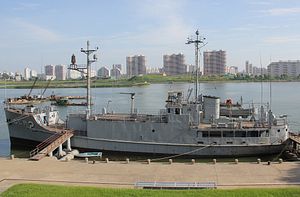Today marks the fiftieth anniversary of the capture of the USS Pueblo by North Korea. On January 23, 1968, the Korean People’s Navy attacked and seized the U.S. Navy intelligence-gathering vessel in the Sea of Japan, taking its crew hostage. Today, the Pueblo sits as a monument to North Korean triumph over the United States on the bank of the Pothong River, which runs through the North Korean capital of Pyongyang. (It remains the second-oldest commissioned vessel in the U.S. Navy, which seeks its return.)
There’ll be a lot written on the Pueblo incident this year, no doubt; instead of recounting the story of the vessel’s capture—and the harrowing ordeal its crew endured at North Korean hands—it may be more useful to use this space to reflect on what today’s U.S. policymakers can take from the incident. (For a thorough treatment of this very topic, check out North Korea-watcher Van Jackson’s book, Rival Reputations; for those with time to dig through primary sources, the Wilson Center’s Digital Archive as a trove of cables from that time.)
The fiftieth anniversary of the Pueblo incident comes at a time of frenzied debate in the United States about what the country should do with regard to North Korea’s fast-moving ballistic missile and nuclear program. Last year, after North Korea carried out three successful flight tests of two different intercontinental-range ballistic missile designs, commentators in the United States grow increasingly concerned that Pyongyang will look to pursue nuclear blackmail and coercion.
Meanwhile, with North Korean Foreign Minister Ri Yong-ho’s threat in the autumn of 2017, on the sidelines of the United Nations General Assembly, to shoot down U.S. B-1B bombers near North Korean airspace, the lessons of the Pueblo (and the lesser-known shootdown of a U.S. EC-121 surveillance aircraft in April 1969) are salient reminders of North Korea’s risk acceptant behavior.
In 1967, North Korea was already wary of surveillance being conducted inside what it saw as its territorial waters by U.S. Navy vessels. An analysis of the incident published in 2015 in the Central Intelligence Agency’s in-house journal, Studies in Intelligence, notes that one of the North Korean officers who interrogated the crew referenced earlier surveillance patrols. In fact, when the North Koreans seized the vessel, they expected to find the USS Banner‘s hull number, not the Pueblo‘s. (Banner was AGER-1, the lead ship of the Banner-class.)
The North Korean obsession with the specific U.S. asset echoes currently obsessions in Pyongyang with U.S. bombers, which flew to the Korean Peninsula on a nearly biweekly basis last year for deterrent missions. The United States even flew B-1Bs north of the military demarcation line in September 2017, taking them closer to North Korean airspace in the Sea of Japan than they’ve been in the 21st century. Amid U.S. President Donald Trump’s threats to “totally destroy” North Korea at the United Nations just days before that, it’s not unimaginable that, like the Pueblo incident, the North Koreans would attempt to deny U.S. bombers free rein near their airspace.
The Pueblo incident is a reminder, too, of North Korean conviction that brinkmanship spilling into outright kinetic coercion can be successful without sparking an all-out war. While the Trump administration mulls over an unacceptably risky and limited “bloody nose” strike against North Korea, Pyongyang has shown itself willing to take offensive action time and time again, convinced it won’t lead to an escalatory spiral. Even decades after the Pueblo, the sinking of the ROKS Cheonan and the shelling of Yeonpyeong Island in 2010 hit home this fact. Nuclear weapons may give North Korea new space for offensive maneuver—even if they can’t help Kim Jong-un realize more fanciful goals like the coercive reunification of the Peninsula.
One final point on the Pueblo incident that continues to be striking is the nature of the bargaining that went on between the United States and North Korea. One U.S. sailor had been killed during the vessel’s capture while 82 others were taken hostage by North Korea, where they were tortured and forced to issue an apology. As the United States and North Korea negotiated the conditions for the crew’s release, it became apparent that neither side could agree on the facts of the circumstances surrounding the Pueblo‘s capture. Ultimately, after months of negotiation, the U.S. acquiesced to signing a North Korean apology statement that it later would later verbally withdraw.
In today’s context, this kind of a protracted and difficult bargaining process taking place with North Korea seems nearly unimaginable. A variety of factors lead to this. First, there’s no open channel for military-to-military communication between the United States and North Korea. Even as the two Koreas resume communication via their cross-Demilitarized Zone hotline, the U.S. would rely on other channels, including North Korea’s permanent mission to the United Nations, for critical communications. Second, the Trump administration simply doesn’t appear to have the disposition the Johnson administration did in handling the fallout of the Pueblo incident (which took place amid considerable escalation in Vietnam, mind you).
The lesson of the Pueblo incident isn’t necessarily that talking to North Korea is necessarily desirable, but it may be necessary—especially if Pyongyang reverts to its long-established ways of seizing the offensive. The Pueblo incident could have sparked a war had decision-makers on either side adjusted their priorities. Today, with a credible array of nuclear escalation scenarios, the stakes are much higher.

































